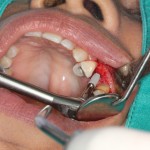
While implants have typically been placed in healed extraction socket there has been an increased interest in placing implants immediately into extraction sockets. Although animal studies have suggested there is no significant difference in success rates when placing implants in infected socket there is controversy regarding this procedure in human studies.
The aim of this review was to assess whether the immediate placement of dental implants into infected vs. non-infected sites changed the risk of implant failure and marginal bone loss.
Methods
Searches were conducted on PubMed, the Web of Knowledge and the Cochrane Library.Two reviewers independently selected studies . Intervention or retrospective human clinical studies that compared the risks of implant failure or marginal bone loss for implants that were immediately placed into infected vs. non-infected sockets were considered.
The primary outcome of interest was implant failure; the secondary outcome of interest was marginal bone loss. Dichotomous outcomes were expressed as risk ratios, whereas continuous outcomes were expressed as mean differences in millimeters. Study-specific estimates were combined using fixed-effects models.
Results
- 7 studies involving a total of 935 patients and 1586 implants were included.
- 5 studies were prospective, 2 retrospective.
- All the studies were considered to be at high risk of bias.
- Overall there were 10 implant failures out of 912 (1.10%) in the control group and 15 failures out of 674 implants (2.23%) in the infected group.
- Meta-analysis (5 studies) found a borderline statistically significant increased risk of implant failure in infected sites compared to non-infected sites. Risk ratio = 2.16 (95%CI; 0.97 to 4.80) P = 0.058.
- For marginal bone loss, there was no statistically significant difference between insertions into infected vs. non-infected sites. Mean Difference = -0.04mm (95% CI: -0.09 to 0.02) P = 0.173.
Conclusions
The authors concluded
This study suggests that the immediate placement of a dental implant into an infected site might increase the failure risk of the implant in comparison with an implant that was placed into a non-infected site. The results of the present meta-analysis should be interpreted with caution because of the presence of uncontrolled confounding factors in the included studies.
Comments
The authors searched a good range of databases for this review only identifying 7 studies all of which were considered to be at high risk of bias. The follow up period ranged from 12-93 months and the overall failure rate was low, which lends support to the authors’ conclusions that the results of this review should be interpreted with caution. Previous reviews of the placement of dental implants in fresh extractions sockets have all suggested that outcomes are poorer that placement in healed sockets.
Links
Primary paper
Zhao D, Wu Y, Xu C, Zhang F. Immediate dental implant placement into infected vs. non-infected sockets: a meta-analysis. Clin Oral Implants Res. 2015 Dec 15. doi: 10.1111/clr.12739. [Epub ahead of print] PubMed PMID: 26667097.
Other references
Dental Elf – 8th Jun 2015 – Dental Implants placed in fresh sockets have poorer survival

Dental implant placement in infected sockets may increase failures https://t.co/WTuYzmf8gN
Placing implants in infected sockets may increase failures https://t.co/WTuYzmf8gN
Review suggests increased failures when dental implants placed in infected sockets https://t.co/WTuYzmf8gN
Dental implants – immediate placement in infected sockets may increase failure rates https://t.co/WTuYzmf8gN
Don’t miss – Dental implant placement in infected sockets may increase failures https://t.co/WTuYzmf8gN